Single-chromosome yeast developed by Chinese scientists
Brewer's yeast, one-third of whose genome is said to share ancestry with humans, has 16 chromosomes.

- Country:
- China
Chinese scientists claimed to have created the first single-chromosome yeast while not affecting the majority of its functions, a breakthrough that could help in furthering research related to aging and diseases in humans.
Brewer's yeast, one-third of whose genome is said to share ancestry with humans, has 16 chromosomes. However, Chinese scientists have managed to fit nearly all its genetic material into just one chromosome while not affecting the majority of its functions, according to a paper released yesterday on the website of the journal Nature.
Qin Zhongjun, a molecular biologist at the Centre for Excellence in Molecular Plant Sciences of the Shanghai Institute of Plant Physiology and Ecology under the Chinese Academy of Sciences, and his team used CRISPR-Cas9 genome-editing to create a single-chromosome yeast strain, state-run Xinhua news agency quoted the research paper as saying.
Yeast is a type of eukaryote, which also includes humans, plants, and animals. Humans have 46 chromosomes, whereas male jack jumper ants have just one. It seems that the number of chromosomes of a eukaryote has no correlation with the amount of genetic information they possess, the paper said.
"Our research shows that all the genetic information can be concentrated in just one chromosome," Qin said.
In the past, researchers had fused two yeast chromosomes together, but no one had ever performed the type of extreme genetic surgery that Qin and his colleagues set out to do several years ago.
Using the CRISPR-Cas9, Qin's team removed the DNA at the telomeres, the ends of chromosomes that protect them from degrading. They also snipped out the centromeres, sequences in the middle that are important to DNA replication, the paper said.
First, they fused two chromosomes, then joined this product to another chromosome, and repeated the process in successive rounds until there was only one chromosome left, it said.
Despite the genetic clipping and restructuring, yeast with one "super-chromosome" is similar to natural yeast in cell growth and gene expression, Qin said.
By simplifying a complex genome system, Qin suggested that the research provides a new approach to studying the functions of telomeres.
Earlier research found that the length of telomeres is related to early aging, the formation of tumors, and other diseases. Telomeres shorten as a cell splits, but if telomeres cannot shorten anymore, the cell dies.
The research may also pave the way for new man-made species in the future.
(This story has not been edited by Devdiscourse staff and is auto-generated from a syndicated feed.)
ALSO READ
Parliament Set to Resume Functions Amid Resolved Stalemate
Controversy in Malshiras: Locals Demand Ballot Paper Re-Poll
Ballot Paper Dreams Dashed: Maharashtra Village's EVM Credibility Concerns
LG Electronics India files draft papers for IPO; South Korean parent to sell 15 pc stake
Sharad Pawar Backs Villagers' Demand for Ballot Paper Repoll










